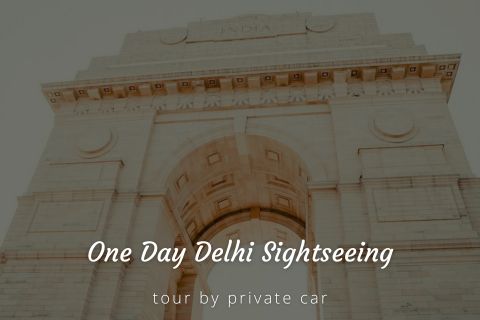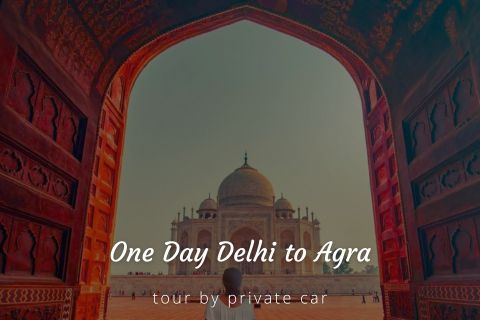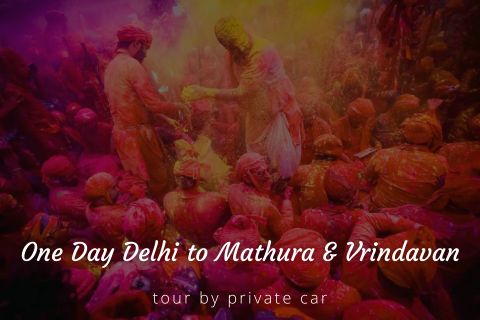Capital of India, the historical and vivacious Delhi is blessed with innumerable monuments, scenic locations and prominent shrines. From historical buildings showcasing Mughal Era and British Raj, to some of the best markets of the country, entertainment zones bustling with activities to sumptuous cuisines from all over the country, Delhi has something for everyone.
Delhi also boasts of some of the best art galleries of India, rich museums and educational institutions. This metropolitan city presents the best of both - modern as well as ancient world. So, plan a Delhi Tour and explore its various attractions. Some of the most popular sightseeing locations to visit in Delhi are given below.
1. Qutub Minar
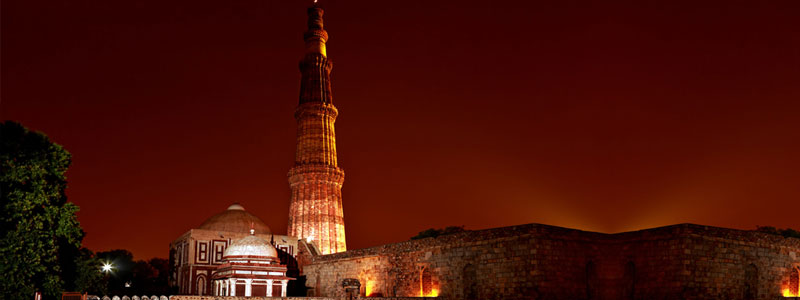
A victory town, located within the premises of Qutub Complex, Qutub Minar is a part of the UNESCO world heritage site. Qutub Complex is located within an ancient fort city named Lal Kot, which was founded by Tomar Rajputs of Delhi. Highest tower of India, it stands with a height of 72.5 metres (238 ft) with a width of 2.75 metres at the top and 14.32 metres at the base.
Built in red sandstone, Qutub Minar was initially built in 1199 AD, by Qutbu'd-Din Aibak for the purpose of muazzin, calls for prayer. Later three more stories were added by Shamsu'd-Din Iltutmish. The tower also received renovations during the rule of Firuz Shah Tughlaq, Sikandar Lodi. Later in 1829, Major R.Smith also renovated Qutub Minar. You can see inscriptions in Arabic on the Minar and around it, there are projected balconies, with intricate carvings.
Other attractions that you must explore around Qutub Minar are Alai Darwaza, Iron Pillar, Quwwat-ul-Islam mosque and the Tomb of Adham Khan. Located in Mehrauli in South Delhi, it is easily accessible by public transport and private cars.
- Timings: 6:00 AM – 8:00 PM
- Entry Fee: Starting ₹35 (Indians), ₹550 (Foreigners)
2. India Gate
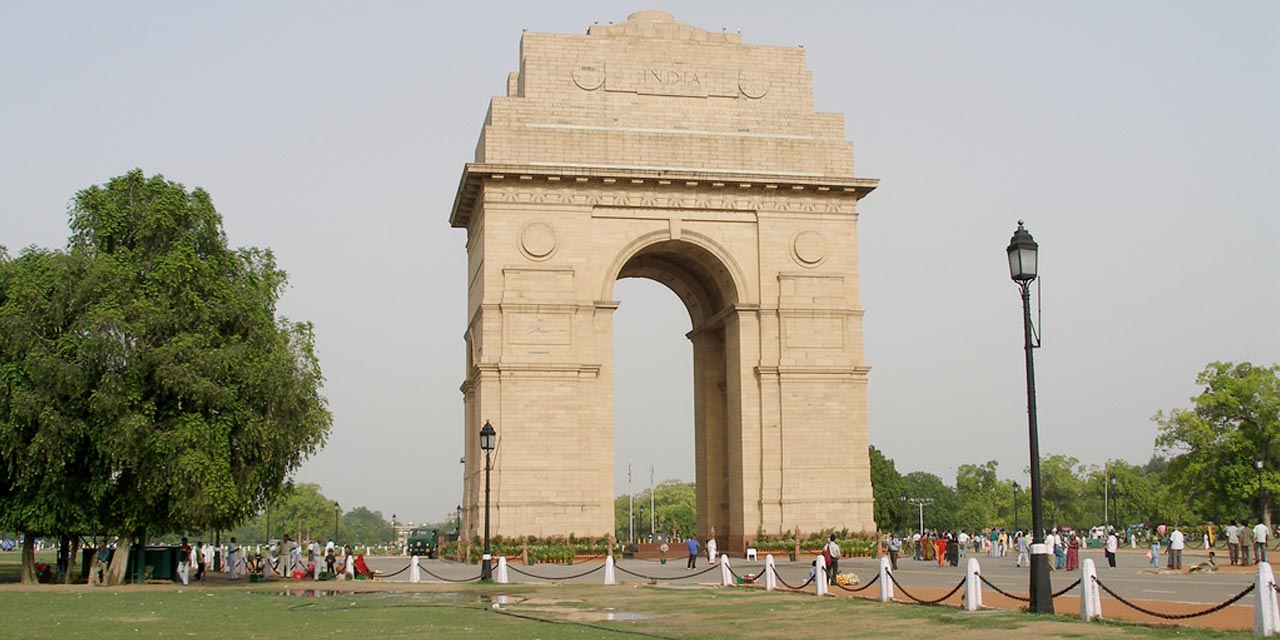
One of the largest war memorials of India, it is located along with Rajpath. A majestic archway, standing in the middle of a crossroad, India Gate was designed by Edwin Lutyens. Its foundation was laid in 1921 by the then Duke of Connaught. This monument was built in the honour of 70,000 soldiers, who were killed during World War I. On the monuments, you can also see the names of around 13,516 Indian as well as British soldiers, who lost their lives in the Afghan war of 1919.
After independence, another memorial, Amar Jawan Jyoti, Flame of the Immortal Soldier, was added to honour the India soldiers who died during the Indo-Pakistan War of December 1971. This eternal flame has been burning ever since its construction. However, later in 2019, a National War Memorial was built in the India Gate Circle near the National War Museum. Since 2022, Amar Jawan Jyothi has been housed within the National war memorial. Around India Gate, there are lawns, ideal for picnic or relaxed stroll. It is also lit at night, making for a beautiful sight.
- Timings: 12:00 AM – 12:00 AM
- Entry Fee: Free
3. Red Fort

Located on the Banks of Yamuna River, Red Fort was built in 1639 by Mughal emperor Shah Jahan when the capital was shifted from Agra to Delhi. Built in Islamic architectural style, this impressive fort is primarily built in red sandstone. There are majestic walls surrounding its impenetrable structure. This fort was the place where the first Prime minister of India, Jawahar Lal Nehru gave first ever Independence speech. Since then, it has been the site for hoisting the National flag on Independence day and speeches by Indian Prime Ministers.
Within the fort, you will find many captivating sections adorned with intricate carvings and designs. Few of the major attractions are the Hall of Public Audiences, Drum House, Palace of Colour, Pearl Mosque, Hall of Private Audiences made up of white marble and Royal Baths. There are many museums and pavilions within the fort. The evening light and sound show is another attraction of Red Fort that must not be missed.
- Timings: 9:30 AM – 4:30 PM (Closed On Mondays)
- Entry Fee: Weekends - ₹80 (Adult), ₹30 (Child); Weekdays - ₹60 (Adult), ₹20 (Child)
4. Humayun’s Tomb
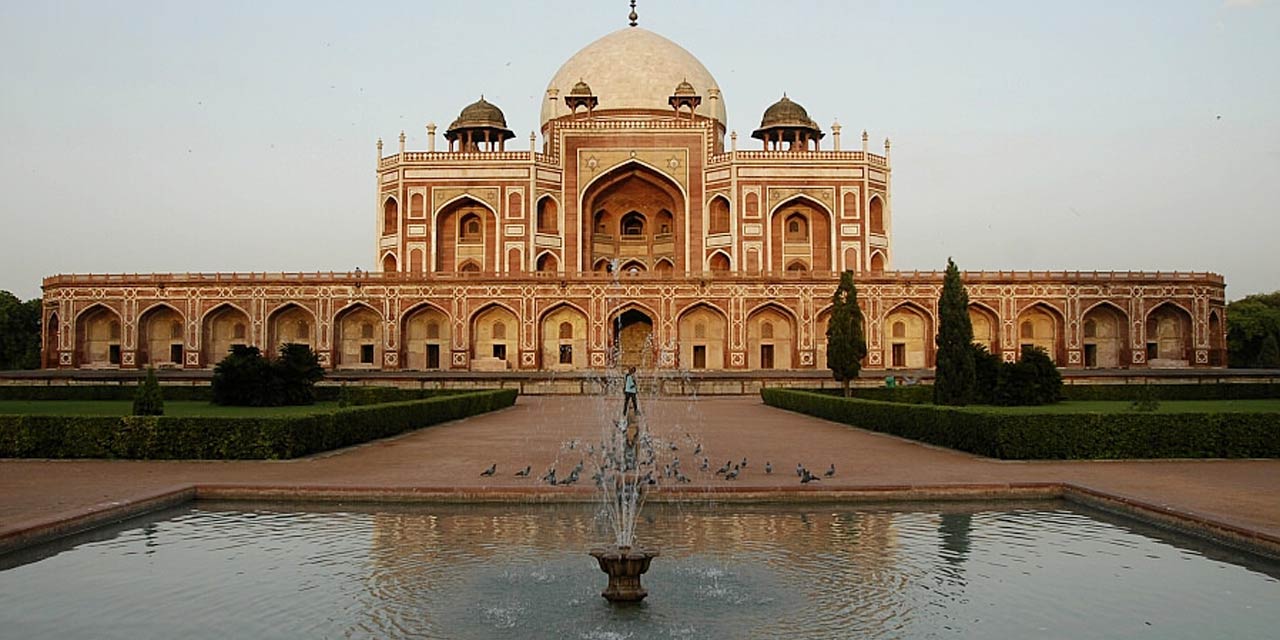
Recognized as a UNESCO World Heritage Site, Humayun’s Tomb, as the name indicates, is a mausoleum of Mughal King Humayun, commissioned by the first wife of Emperor Humayun - Empress Bega Begum. This tomb was designed by the persian architect Mirak Mirza Ghiyath and his son Sayyid Muhammad. It has a height of 47 metres high and a width of 91 metres and showcases Mughal architectural style, with a hint of Persian architecture.
The tomb is surrounded by well-maintained gardens, popularly known as the Charbagh gardens of Humayun’s Tomb. The complex is also the final resting place of other Mughal royals, such as Queen Bega Begum, Queen Hamida Begum and Dara Shikoh, who was the son of Emperor Shah Jahan. Humayun’s tomb is located quite close to Nizamuddin Dargah, which is another popular sightseeing location in Delhi.
- Timings: 6:00 AM – 6:00 PM
- Entry Fee: ₹40 (Indians), ₹600 (Foreigners)
5. Swaminarayan Akshardham Temple
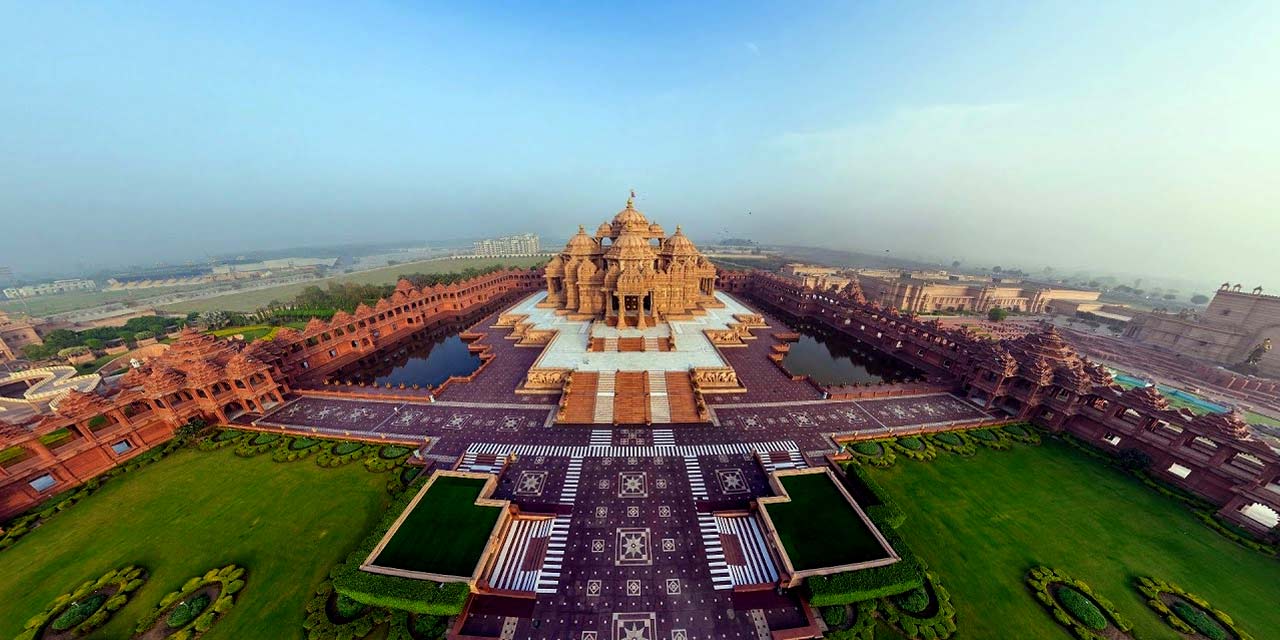
The largest comprehensive Hindu temple in the world, Swaminarayan Akshardham complex has been recognised under the Guinness World Record. Opened in 2005 by Dr. APJ Abdul Kalam, it has been one of the prominent attractions of Delhi. It was built under the guidance of HDH Pramukh Swami Maharaj of the Bochasanwasi Shri Akshar Purushottam Swaminarayan Sanstha (BAPS).
This massive temple complex showcases India's cultural, traditional and spiritual history. This temple complex has a main temple in the centre and is surrounded by captivating structures and gardens. It has the country’s largest step well. The musical fountain show in the evenings, Circle of Life, must not be missed when you are here. Abhishek Mandap, Lotus garden in the shape of a lotus, along with Garden of India, which is 66 acres of lush greenery are other attractions here.
- Timings: 10:00 AM – 6:30 PM (Closed On Mondays)
- Entry Fee: Starting ₹110 (Adults), ₹80 (Child)
6. Lotus Temple
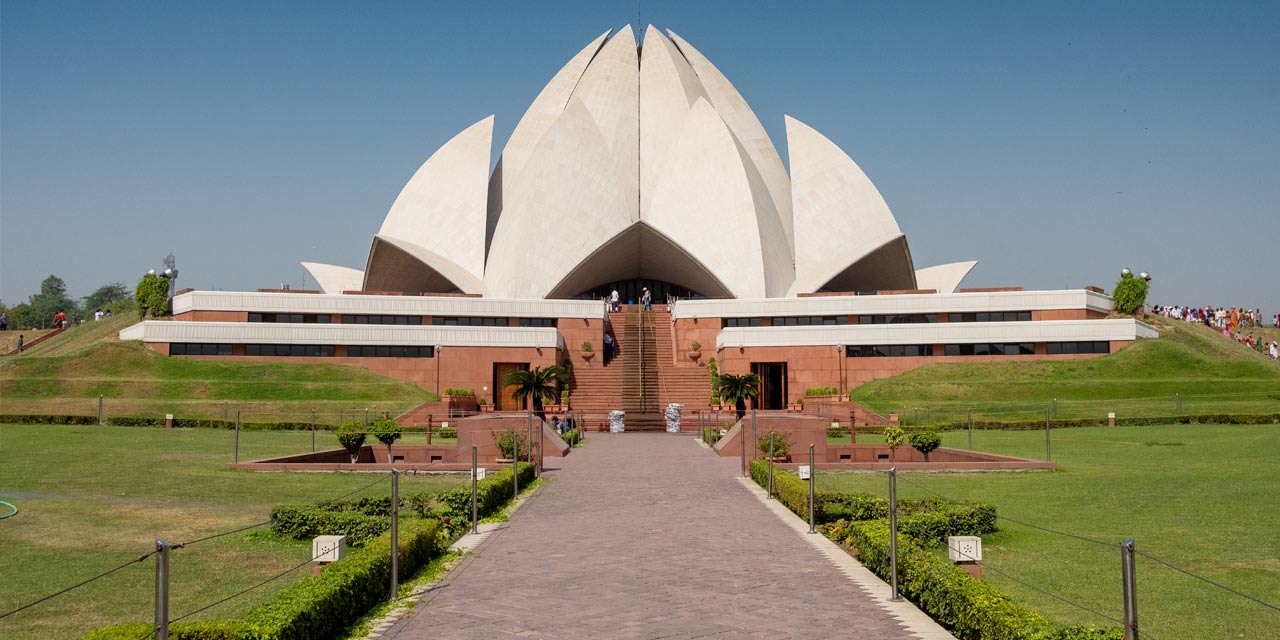
A Baha’i House of Worship, Lotus Temple is not to be missed when you are in Delhi. This temple is known for its unique structure, which is in the shape of a white lotus flower. It was built in 1986 and has been a place of great popularity since then. It has seen more than 10 million visitors by 2014.
Made up of white marble, its design of a lotus flower with captivating petals, was conceptualised by Canadian architect Fariborz Sahba. This structure represents the philosophy behind the temple, which is of a harmonious living, respecting all the religions. People from all religious backgrounds can visit and worship here. Nine pools around the lotus petals, which are lit at night, are also worth capturing here.
- Timings: 8:30 AM – 6:00 PM (Closed On Mondays)
- Entry Fee: Free
7. Hazrat Nizamuddin Dargah

A Delhi trip is complete only when it includes a visit to the legendary Hazrat Nizamuddin Dargah. Dedicated to the Sufi Saint Nizamuddin Chisti, this shrine is visited by devotees from all the religions. Promoting the equality of all religions, this dargah is the final resting place of Saint Nizamuddin Chisti.
The mausoleum is built in red sandstone and white marble. Here you will also find tombs of Jahan Ara Begum, who was the daughter of Shah Jahan and Mumtaz Mahal, revered poet Mirza Ghalib and the Sufi poet and singer Amir Khusrow. The spiritual aura of the shrine is sure to leave you peaceful.
Often featured in bollywood movies, this shrine is also known for the everyday qawwali sessions in the evening by various Sufi saints. It is open from 5 AM to 10.30 PM everyday. It is only 8 km from the New Delhi Railway Station while the closest metro station is the Pragati Maidan and Indraprastha, Delhi.
- Timings: 5:30 AM – 10:00 PM
- Entry Fee: Free
8. Birla Temple/Lakshmi Narayan Temple

The first large temple of modern India in Delhi, Birla Temple was built between 1933 to 1939 by industrialist Baldeo Das Birla and his sons. Spread over 7.5 acres of land, this temple has a beautifully manicured garden, fountains and a hall (Geetha Bhawan) for discourses. All this in addition to a captivating main temple, dedicated to Lord Vishnu and his consort Goddess Lakhsmi.
The idol is also referred to as Lord Lakshmi Narayana. The idols are made up of marble brought from Jaipur, while the temple is made with Kota stones from Agra, Makrana, Kota, and Jaisalmer. It was designed by Sris Chandra Chatterjee, who is considered to be the pioneer of Modern Indian Architecture Movement. The temple is visited by hordes of devotees especially during festivals like Diwali, Janmastmi, etc.
- Timings: 4:30 AM – 1:30 PM, 2:30 PM – 9:00 PM
- Entry Fee: Free
9. Purana Quila
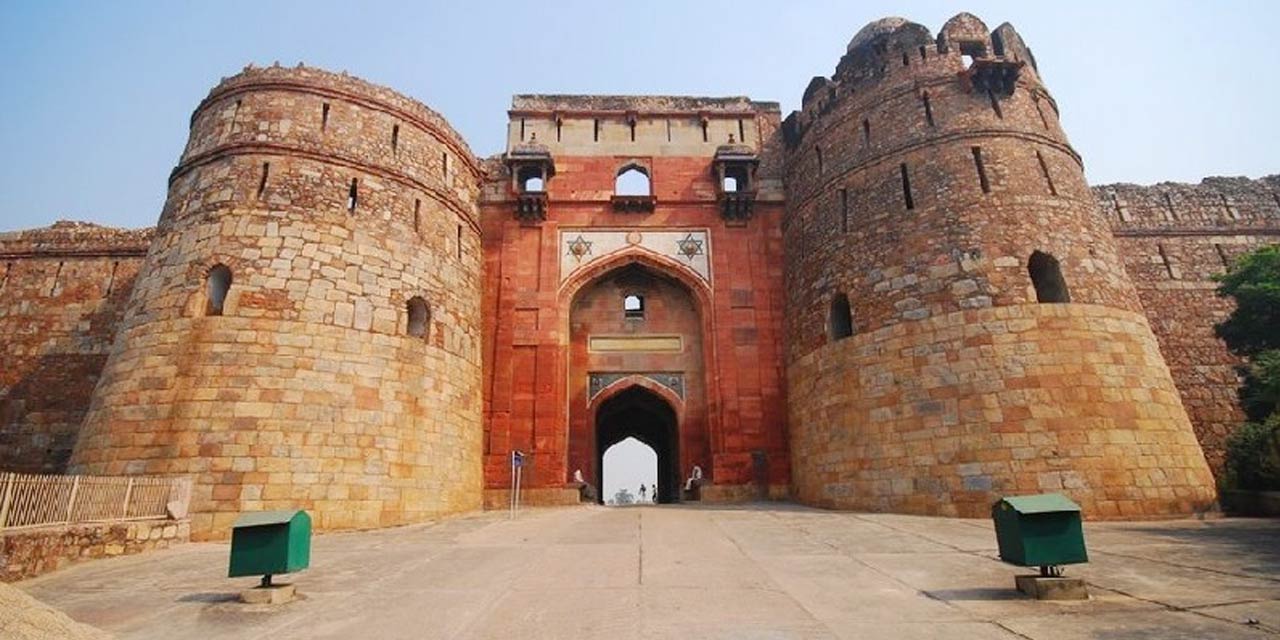
Built during the rule of Emperor Humayun and Afghan Sher Shah Suri, it is an old fort with an impressive structure, which appears sturdy even after decades of its construction. Also known as Old Fort, it is surrounded by massive walls with a height of 18 metres. There are three arched gateways, adorned with white and colourful marble inlays and blue titles.
The gate facing the east, known as the Bada Darwaza is still being used. The gate located towards the south of the fort is called Humayun Gate as it was built by the emperor himself. From this gate one can see Humanyun’s tomb. And the third gate is known as the Talaqi (Forbidden) Gate. There is a touch of Rajasthani architecture in the gates such as jharokhas and chattris.
Another major attraction of the Purana Quila is the Qila-i-Kuhna mosque built in 1541, which has pre-Mughal style of architecture. It has a single dome with five gateways. Shermandal is also worth noticing. The conduction of this double-storeyed octagonal tower was started by Sher Shah but was later completed by Humayun.
- Timings: 7:00 AM – 5:00 PM
- Entry Fee: ₹30 (Indians), ₹300 (Foreigners)
10. Gurudwara Bangla Sahib
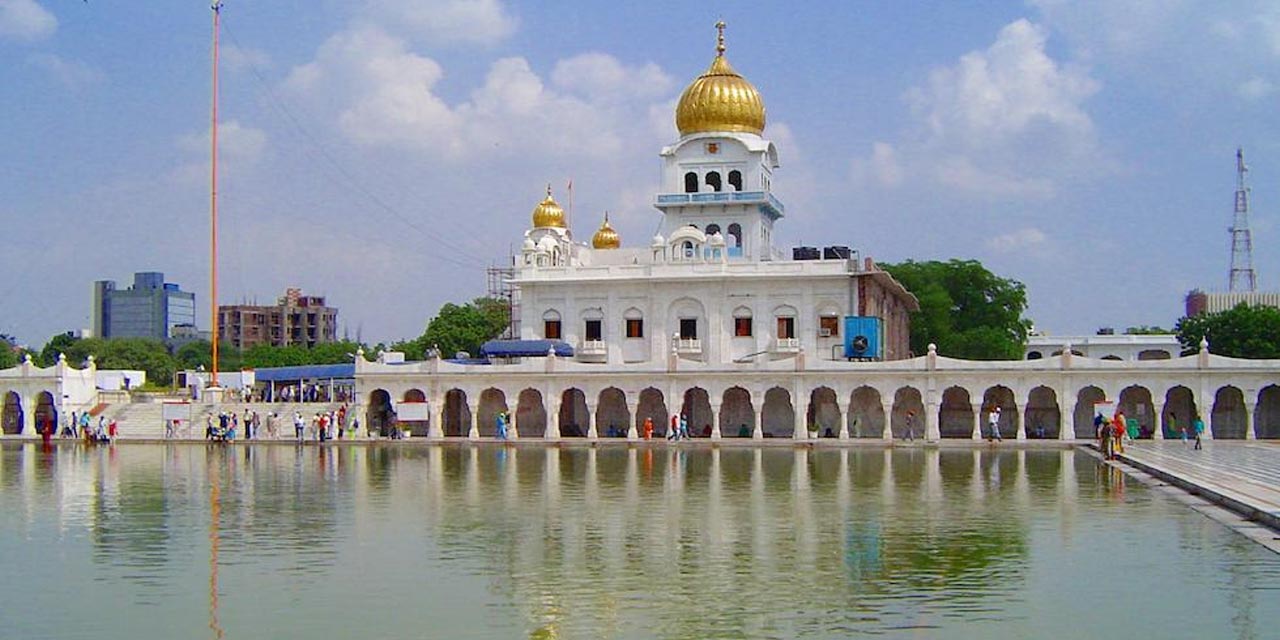
A significant shrine among Sikh devotees, Gurudwara Bangla Sahib was built in 1783 by Sikh General Sardar Baghel Singh. This shrine is associated with Guru Har Krishan Singh, who was the eighth Sikh Guru.
Once a Bungalow, named Jaisingh Pura palace, owned by Raja Jai Singh, it was the place where Guru Har Krishan Singh had stayed in 1664. During the epidemic of smallpox and cholera, he had served people from this place and even offered water from a well within the bungalow. Later a tank was also built by Raja Jai Singh. It is believed that the waters of the tank hold healing properties and are often carried by devotees.
Within the complex of the gurdwara, you will find a hospital, library, Baba Baghel Singh Museum and a higher secondary school.
- Timings: 12:00 AM – 12:00 AM
- Entry Fee: Free
11. Hauz Khas

Now one of the most vibrant places of South Delhi, with exciting nightlife, high end boutiques, art galleries, cafes and pubs, Hauz Khas was built in the 13th century. It beautifully combines modern glamour with the awe-inspiring architecture of various monuments. This heritage site has monuments, dating back to the 14th to 16th century.
Built during the reign of Delhi Sultanate, Hauz Khas complex consists of a water tank dating back to Alauddin Khilji rule, tomb, mosque, pavilion and Islamic seminary. Tomb of Firoz Shah is a major attraction here, which was built by Firoz Shah Tughlaq himself as his final resting place. Hauz Khas village was also considered as the Medieval Centre of Learning with several scholars and students arriving to study at the Madrasa.
- Timings: 10:30 AM – 7:00 PM (Closed On Sundays)
- Entry Fee: Free
12. National Railway Museum
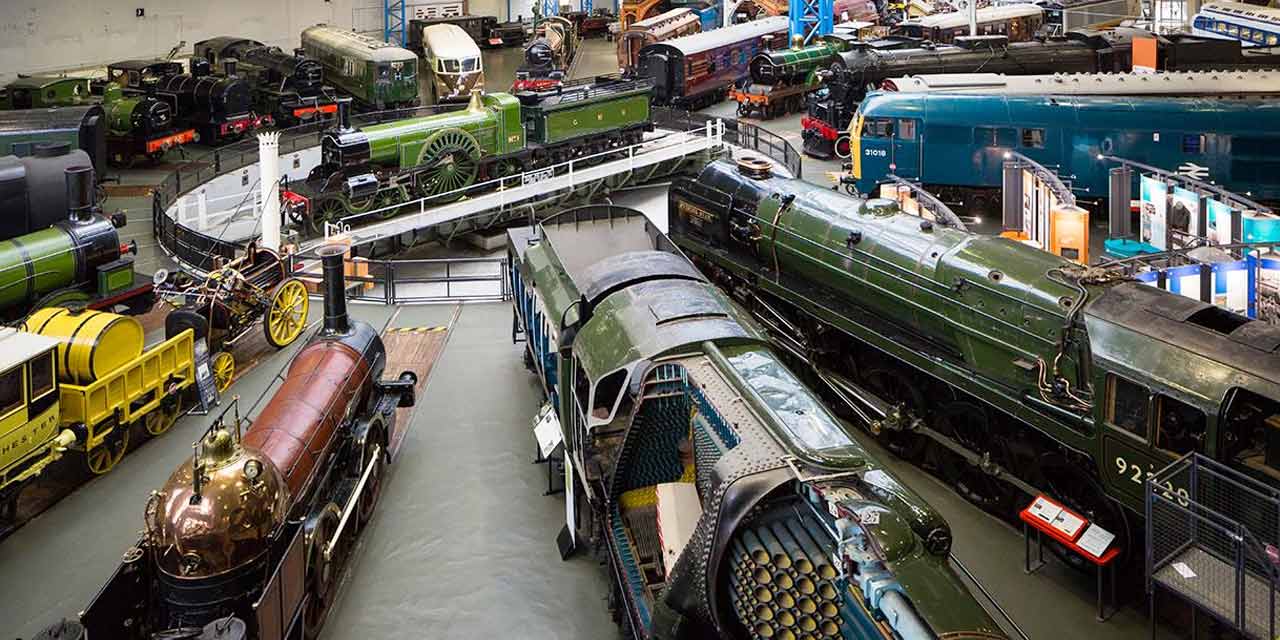
If you are travelling with kids or love trains, then the National railway Museum is a must visit. First of its kind in India, the foundation of the National Rail Museum was laid in 1971 and was opened in February, 1977. Earlier known as the Rail Transport Museum, it showcases the grand heritage of India's railway. Spread over 10 acres of land, it has several indoor and outdoor exhibits. It boasts of having the largest assembly of life-size railway exhibits.
Fire Engine, Diesel simulator, Coach Simulator, 1:8 scale trail, electric locomotive 4502, Steam simulator, Saloon of Prince of Wales, Saloon of Maharaja of Indore and Mysore, Patiala State monorail trainways along with Fairy Queen, which is the oldest steam locomotive are few of the exhibits here. The indoor galleries also have drawing books, documents and maps on display.
The train ride, Joy Train and 3D Virtual Coach Ride, are also popular here, especially among children. Located in Chanakyapuri, it has the nearest metro station at Dhaula Kuan. It is open on all days of the week, except Mondays.
- Timings: 10:00 AM – 5:00 PM (Closed On Mondays)
- Entry Fee: Starting ₹50 (Adult), ₹10 (Child)
13. Raj Ghat
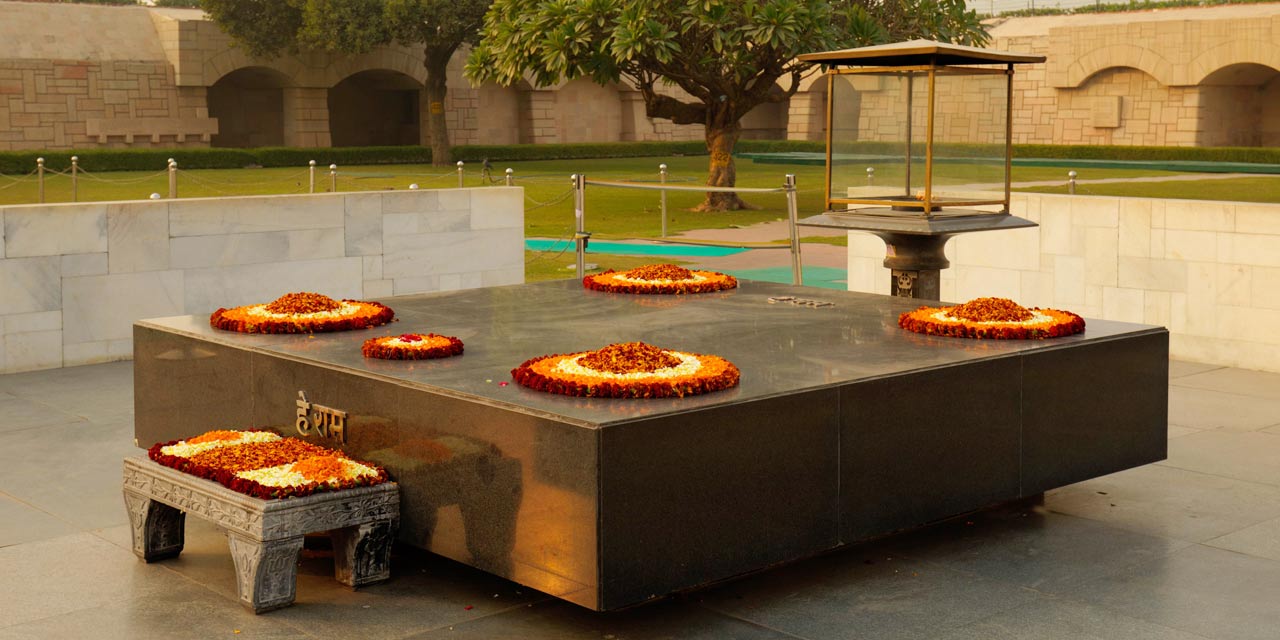
Situated on the banks of Yamuna River, it is a memorial dedicated to Mahatma Gandhi, Father of the nation. It is a black marble platform, which was built to mark the place of Mahatma Gandhi’s cremation. This raised marble platform has an eternal flame, which has been burning ever since its construction. The last words of Mahatma, ‘hai ram’, have been inscribed in front of the memorial.
It is a walled structure where one can enter only barefoot. All the big leaders and dignitaries from around the world have visited RajGhat to pay their respect to the world’s greatest leader. Outside the walled compound, you will find a lush green garden. Located on the Mahatma Gandhi Road, it is only 5 km from New Delhi railway station. The nearest metro station is the Delhi Gate metro station.
- Timings: 6:00 AM – 6:00 PM
- Entry Fee: Free
14. Chandni Chowk
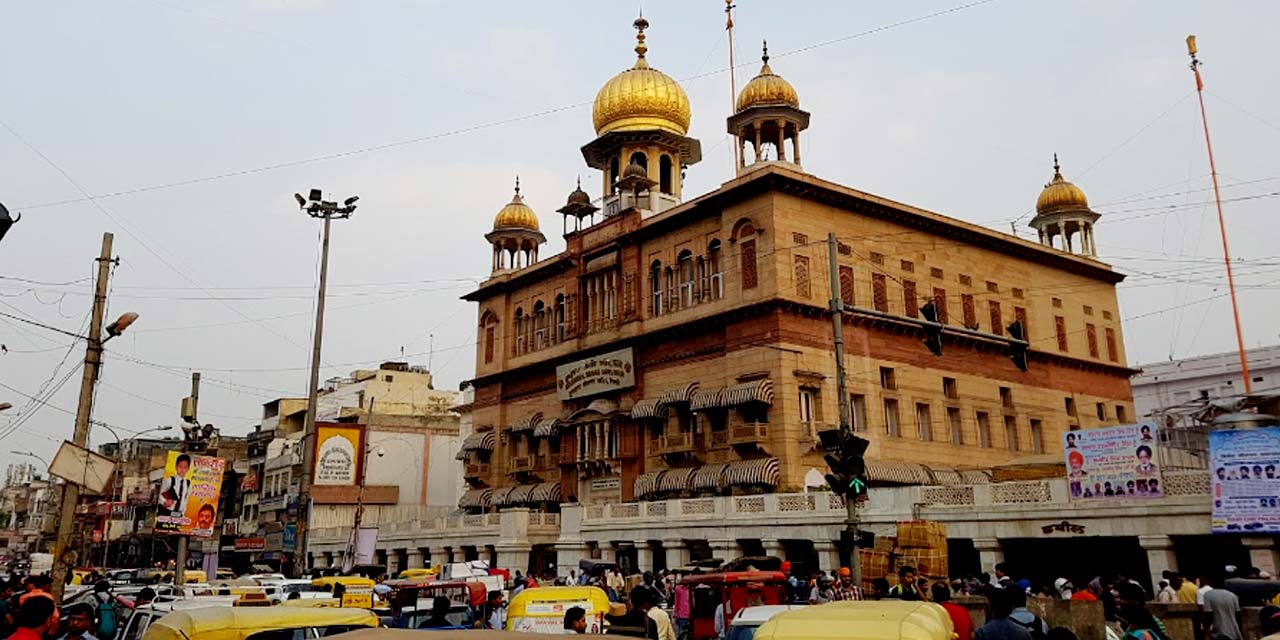
One of the oldest markets not just in Delhi but in entire India, Chandi Chowk was built in 1650 by Jahan Ara Begum, daughter of Mughal Emperor Shah Jahan. It was built in a square shape. It has a water pool at the centre, which used to reflect the moonlight, which also led to its name.
It is also one of the biggest markets in the country, with shops selling all kinds of items, including traditional and modern wear, wholesale hardware, industrial chemicals, kitchen items, dry fruits and herbs, fashion as well as gold and silver jewellery.
Along with shopping it is also known for its eateries. The famous Parathe Wali Gali is located at Chandni Chowk. There are also many shrines located in and around this place such as Sri Digambar Jain Lal Mandir, Shri Shiv Navgrah Mandir Dham, Gauri Shankar Temple, Gurudwara Sis Ganj Sahib, Sunehri Masjid and Central Baptist Church. It is also quite close to the Red Fort of Delhi.
- Timings: 9:30 AM – 8:00 PM (Closed On Sundays)
- Entry Fee: Free
15. Dilli Haat
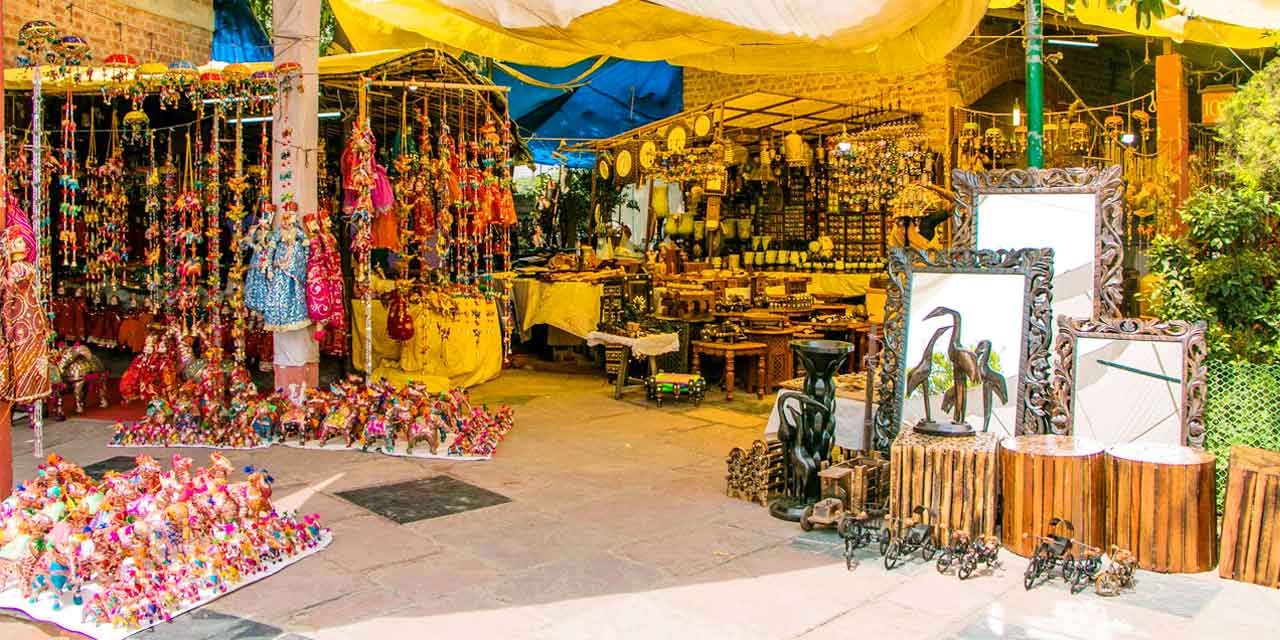
A permanent market, which is also a popular tourist village, Dilli Haat is managed by the Delhi Tourism and Transportation Development Corporation. This unique colourful market, which also showcases India’s cultural heritage and traditions, is an ideal place to shop, relax and have fun.
It has more than 60 shops selling handicrafts from all over the country. From handmade jewelleries, home decor, brass, silver and wood items, to footwears and fabrics, to toys and gems, you will find a lot of options here, each with a unique Indian touch. It also has many eateries with varied culinary choices. Along with this, a lot of events like music and dance performances are also organised here. Located centrally, Delhi Haat is quite close to the INA, New Delhi metro station.
- Timings: 11:00 AM – 9:00 PM
- Entry Fee: ₹30 (Indians), ₹100 (Foreigners)
16. Jama Masjid
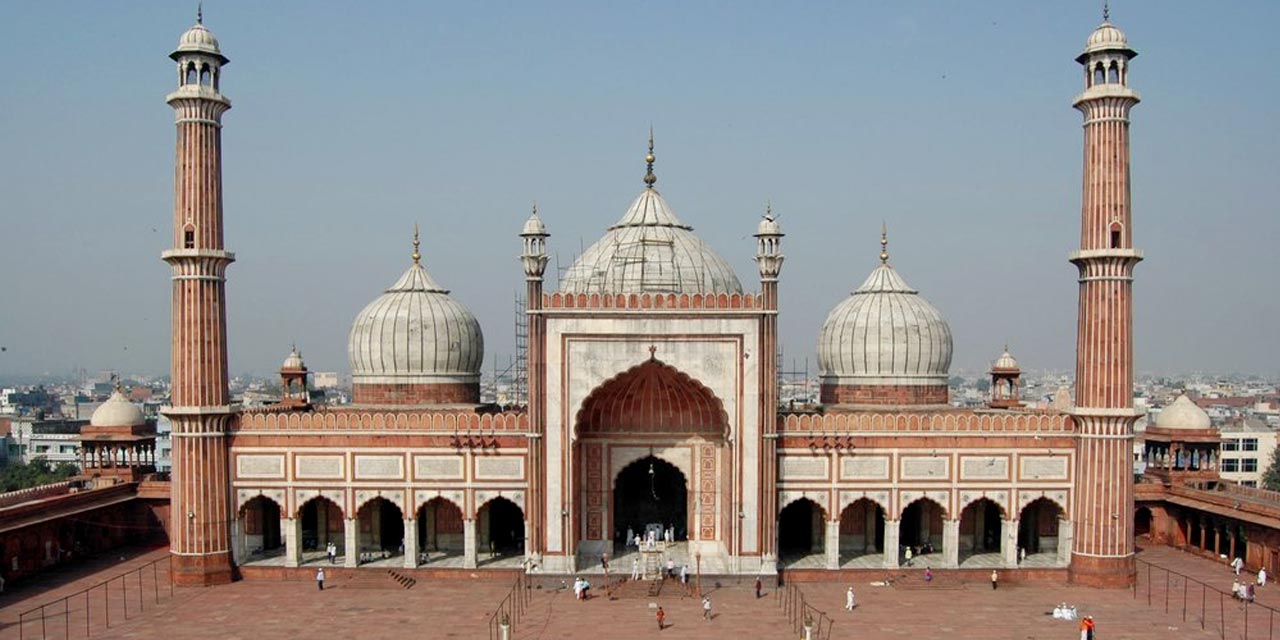
Built by Mughal Emperor Shah Jahan between 1650 and 1656, Jama Masjid is the largest mosque of India with a capacity to house more than thousands of pilgrims. It has an impressive structure made up of red sandstone and marble, which is said to be built by around 5000 workers.
It consists of three majestic gates, four towers and two minarets with a height of 40 metres. The main courtyard of the mosque can accommodate around 25,000 workshipers. When visiting the mosque, it is advisable to rent robes from the northern gate or to dress in modest clothes, covering legs, shoulders and head. Visitors are not allowed during the prayers, so plan your visit accordingly. The nearest metro station is the Jama Masjid station. However, if you are travelling by bus, then the nearest bus stand is the Kashmere Gate ISBT, which is 2 km away.
- Timings: 7:00 AM – 12:00 PM, 1:30 AM – 6:30 PM
- Entry Fee: Free (Indians), ₹400 (Foreigners)
17. Lodhi Garden

Spread over 90 acres of land, Lodhi Garden is blessed with vast lawns, refreshing air and captivating monuments. Before Independence, it was called Lady Willingdon Park. This beautifully laid out garden is home to tombs of King Sikandar Lodhi and King Mohammed Shah. You will also find Bara Gumbad, and Shisha Gumbad within the garden premises.
Showcasing the architectural style during the rule of Sayyid dynasty and the Lodhi Dynasty, these tombs stand majestically against the backdrop of refreshing greenery. Located between the Khan Market and Safdarjung's Tomb, Lodhi Garden is easily reachable. The nearest metro station is the Jor Bagh Metro Station.
- Timings: 5:00 AM – 8:00 PM (April-Sep), 6:00 AM – 8:00 PM (Oct-March)
- Entry Fee: Free
18. Jantar Mantar
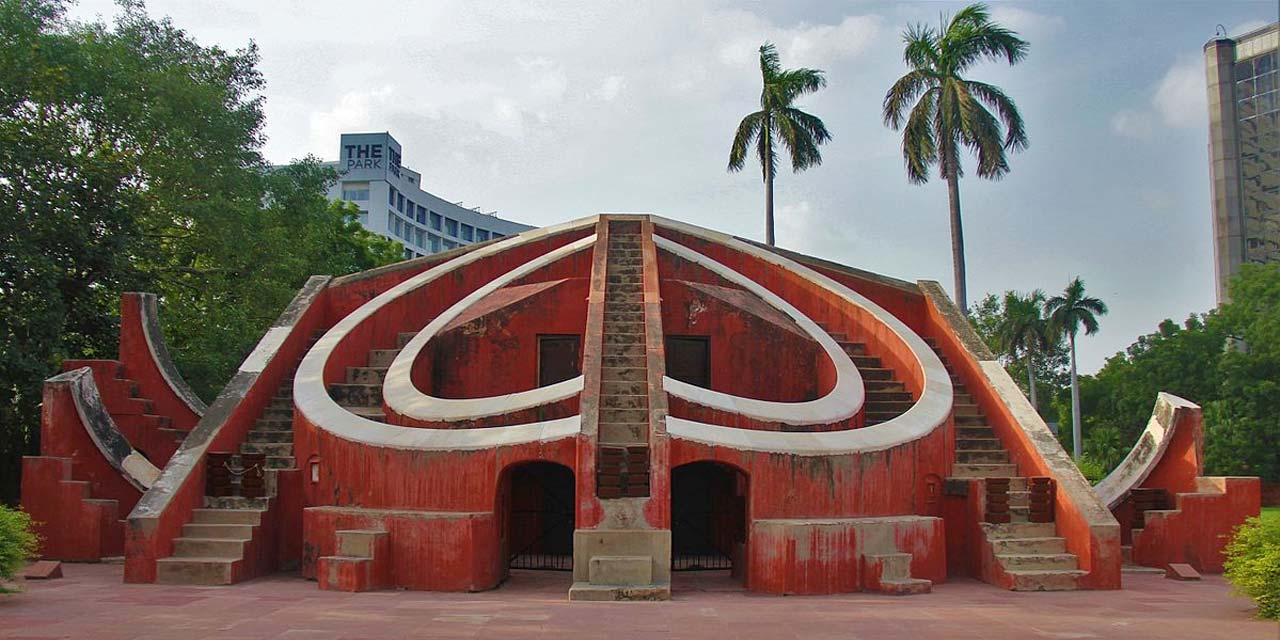
A UNESCO World Heritage site, Jantar Mantar is a unique complex dedicated to astronomy. It houses 13 architectural astronomy instruments. The prominent instruments here are the Samrat Yantra, Ram Yantra, Jai Prakash, and Misra Yantra. This ancient observatory was built by Maharaja Jai Singh II.
With the literal meaning of ‘instruments for measuring the harmony of the heavens’, Jantar Mantar is a representation of Maharaj’s interest in astronomical learning and ways to observe and study the field. Its construction was started in 1724 and since then the instruments made up of brick and limestone have undergone few restorations.
Just 7 km from Kashmere Gate ISBT, it is open from 9 AM to 7 PM. If you are travelling by auto then the nearest station is the Rajiv Chowk Metro Station.
Similar kinds of Jantar Mantar were also developed by Maharaja Jai Singh II in other cities of India, namely Jaipur, Varanasi, Mathura and Ujjain.
- Timings: 6:00 AM – 6:00 PM
- Entry Fee: ₹20 (Indians), ₹250 (Foreigners)
19. Agrasen ki Baoli
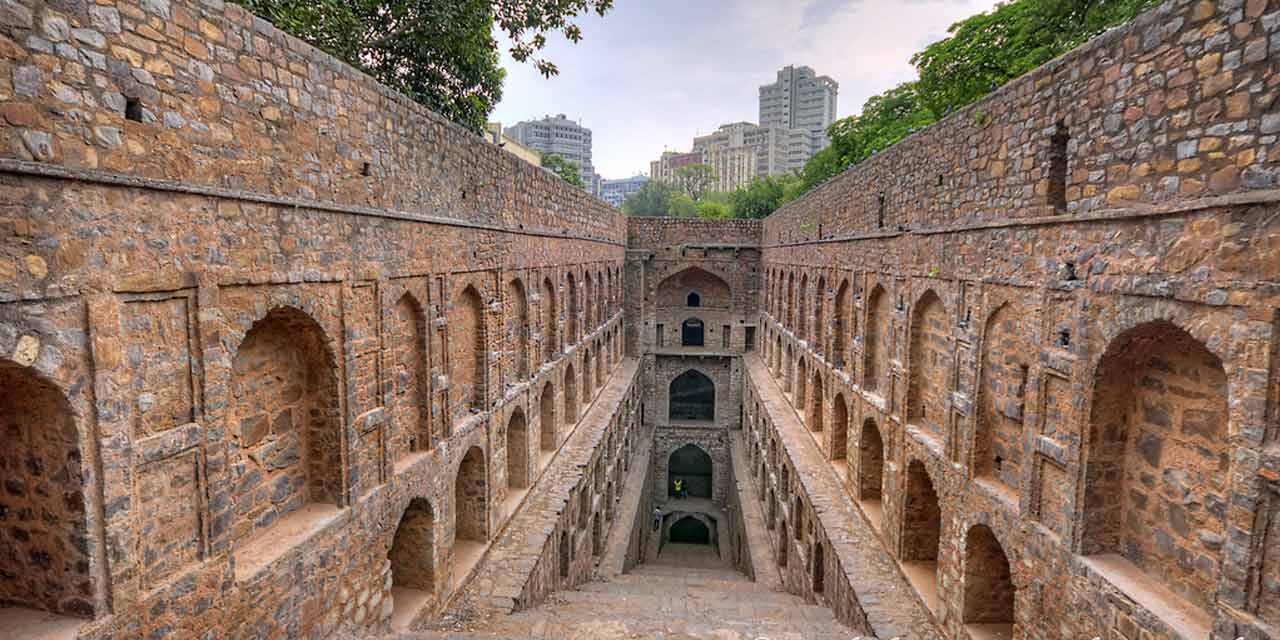
A popular monument to visit in North Delhi, Agrasen ki Baoli is architecturally beautiful stepwell and is now protected by the Archaeological Survey of India under the Ancient Monuments and Archaeological Sites and Remains Act of 1958. There is not much data on its construction. However, it can be traced back to the Chahal Dynasty. It was later rebuilt in the 14th century during the Lodhi reign.
This deep stepwell has a width of 15 metres and 60 metres of height and consists of 108 steps. It has three levels, each level with arched openings on both the sides.
Located near Connaught Place, which is also a popular place to visit in Delhi, Agrasen ki Baoli has become more popular after featuring in cinemas like the bollywood movie PK. Barakhamba Road Metro Station is the nearest metro station for reaching here. If you are travelling by city buses then you get down at the Kashmere Gate ISBT, which is around 9 km away.
- Timings: 9:00 AM – 5:30 PM
- Entry Fee: Free
20. Sarojini Nagar Market
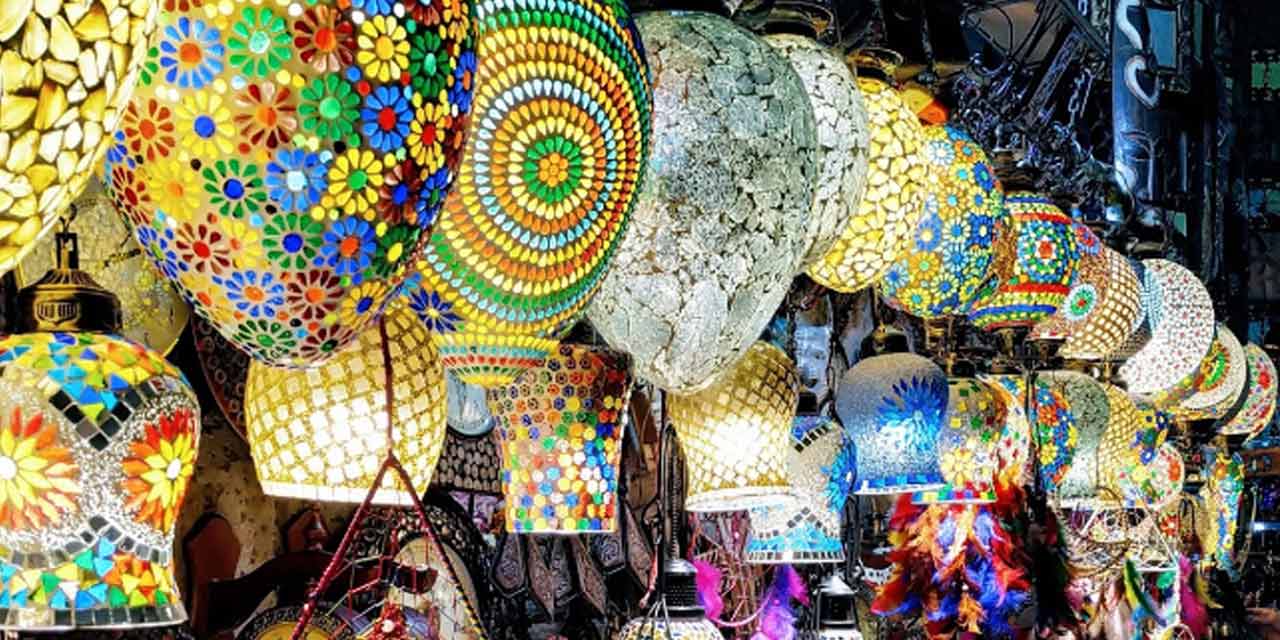
One of the most famous shopping places in Delhi, Sarojini Nagar Market is absolutely unmissable on your Delhi Tour. Not only shopping, it offers a glimpse of the local life as well. This huge market has many sections, each catering to different categories of items. Some of the common parts of the Sarojini market are Subzi Market, Babu Market, Mandir Wali Side Market and the Central Market.
Here you will find shopping choices ranging from traditional and modern clothes, food items to accessories and home decor. When visiting here, make sure you bargain extensively for each item to get the best possible price. Shops here are open from 10 AM to 9 PM all throughout the week, except Mondays. So plan your visit accordingly.
- Timings: 10:00 AM – 9:00 PM
- Entry Fee: Free
21. Delhi Zoo

Spread over 176 acres of land, Delhi Zoo is a must visit, especially when you are travelling with children. Its construction was started in 1956 which was completed in 1959. This zoo boasts of more than 1300 animals. Here you can see arrangements that have been made to somewhat recreate the natural habitats of various animals. Also known as the National Zoological Park, it is home to wild animals like black buck, tiger, leopard, elephants, wild boar, jaguar, etc.
Within the premises of the zoo, you will find a souvenir shop, ATM facility, cloakrooms. There are also battery operated trolley and wheelchair facilities here. Located on the Mathura Road in Sundar Nagar, Delhi Zoo is closest to the Pragati Maidan Metro Station.
- Timings: 8:30 AM – 5:30 PM (Summers), 9:00 AM – 5:00 PM (Winters)
- Entry Fee: Starting ₹100 (Adult), ₹70 (Child)
22. Garden of Five Senses
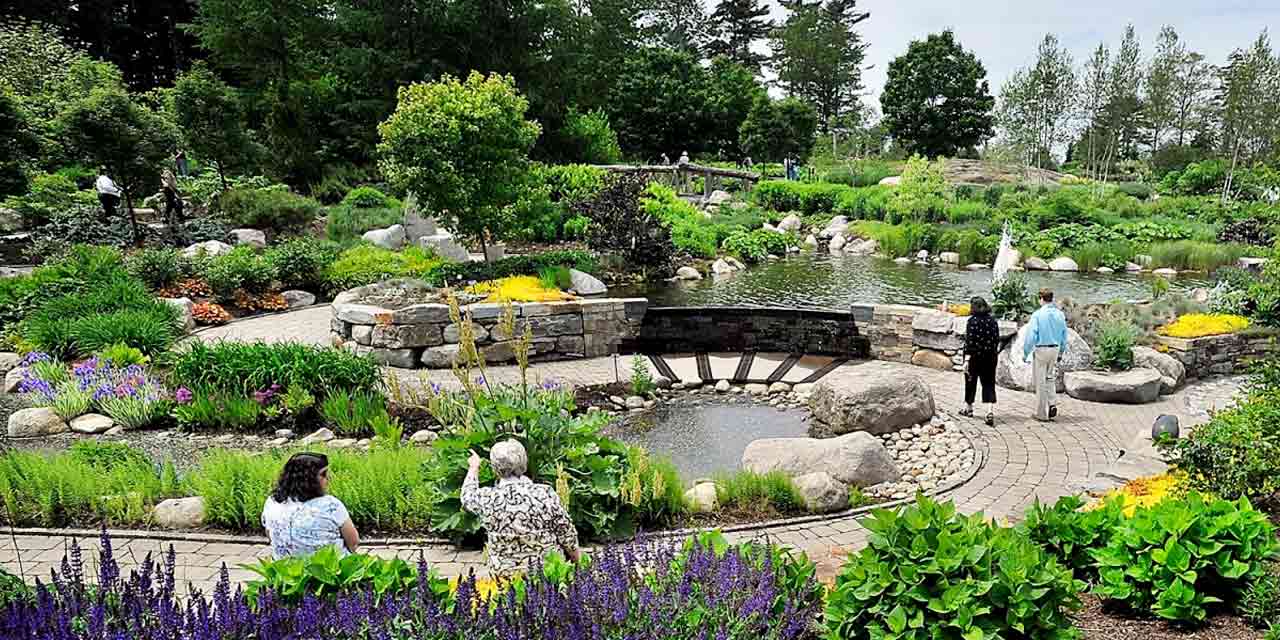
Located in Saidul Ajaib village, which is quite close to the Mehrauli heritage area, Garden of Five Senses is a unique place to visit. Developed by the Delhi Tourism Department in 2003, this park was built to cater as a recreational space for the locals and tourists, promising to relax all our five senses. It has various sections such as Khas Bagh, Neel Bagh, Mughal Garden, nature walk lined with trees and flowering plants and captivating fountains.
Sculptures like the A fountain Tree are also worth noticing. The Fio Country Kitchen and Bar within the garden premises is a popular restaurant here. Along with it, there is also a shopping centre and a food court. The nearest metro station is the Saket metro, which is at a walkable distance.
- Timings: 8:30 AM – 5:30 PM (Summers), 9:00 AM – 5:00 PM (Winters)
- Entry Fee: Starting ₹100 (Adult), ₹70 (Child)
23. Khan Market

Another market that you can not miss in Delhi is the Khan Market. Established in 1951 in the honour of Khan Abdul Jabbar Khan, it is one of the oldest markets of Delhi. This U shaped, double storey market with 154 shops was initially only a residential building which was later converted into a commercial space. It is now a popular and posh area of the city, boasting of being the most expensive retail area of the city.
There are boutique shops, showrooms, book stores, and high-end eateries here. So if you wish to pamper yourself with a touch of luxury then visit Khan market to spend time with your family or friends. Located on the Humayun Road, it can be reached via the Khan Market metro.
- Timings: 10:00 AM – 12:00 AM (Closed On Sundays)
- Entry Fee: Free
24. Rashtrapati Bhawan
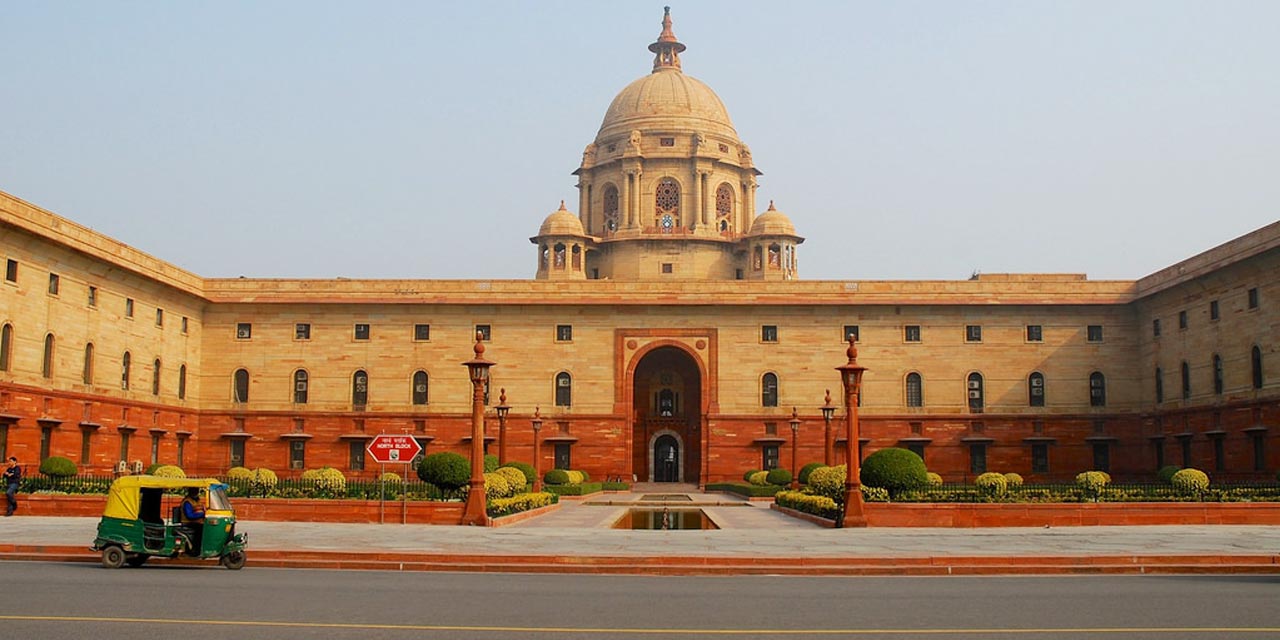
One of the most impressive structures of Delhi, Rashtrapati Bhavan is the home to the President of India. Designed by Sir Edwin Lutyens and Herbert Baker, it is built over 330 acres of land. There are 340 rooms, spread over four floors of the Rashtrapati Bhavan. It is surrounded by several acres of garden and has a corridor of 2.5 kilometres length.
There are many beautiful sections in this intricately designed structure such as the terrace garden, long or purdah garden, main garden with lotus shaped fountains and charbagh, Amrit Udyan with Mughal and Persian style of landscaping, Ashoka Mandap, Gantantra Mandap and a museum.
To visit the Rastrapathi Bhavan, Indian nationals are required to carry a valid proof of identity and the foreign nationals are required to seek permission with a photocopy of their passports. On the day of visiting, original ID proof is a must. The nearest metro station is the Central Secretariat.
- Timings: 9:30 AM – 4:30 PM (Closed On Mondays)
- Entry Fee: Starting ₹50 Per Person
25. Feroz Shah Kotla Fort
Built by the Sultan Feroz Shah Tughla in 1354, this fortress was an integral part of his dream of creating a new version of Delhi kingdom as Firozabad. Now in ruins, this fortress used to be an imposing structure with impenetrable walls and majestic structures within its complex. In the middle of the fortress you can still see a Topra Ashokan pillar, dating back to the 3rd century.
Other attractions at the Feroz Shah Kotla Fort are Jami Masjid, a Baoli and a vast garden complex. Often associated with paranormal activities, this fort is a popular site for anyone seeking thrill and unique excitement. It is also a common site for picnics. The closest metro station to Kotla Fort is the Pragati Maidan metro station. It is open on all days, except Mondays, from 6 AM to 6 PM.
26. Mehrauli Archaeological Park
Spread over 200 acres of land, this massive archaeological site is a heaven for history buffs. It is home to more than 100 historical monuments, each showcasing a significant time in Delhi and India’s history. You will see monuments belonging to the Tughlaq Dynasty, Khilji Dynasty, Lodhi Dynasty of Delhi Sultanate, Mughal Empire and British rule.
Some of the major monuments here are Tombs of Balban, Tomb of Quli Khan, Rajon ki Baoli, Madhi Mosque, Gandhak ki Baoli and Jamali Kamali Mosque. There are also remains of monuments like Zafar Mahal, Mughal Palace and an empty space which was supposed to be the burial place of Bahadur Shah Zafar.
It is located near to the Qutub Minar Complex, so you can club both the visits together. The nearest metro station to this park is Qutub Minar Metro Station. It is open from 5 AM to 6.30 PM on all days of the week.
27. Safdarjung Tomb

Built in 1754, it is the tomb dedicated to Safdarjung, the Prime Minister of the Mughal Empire during the rule of Ahmad Shah Bahadur. It is known as the last enclosed garden tomb in Delhi. Made up of sandstone and marble, it has been built in a style similar to Humayun’s tomb. Every section of the tomb is architecturally beautiful with adorned arches, domes with intricacies designs and well-laid out garden.
With a Char Bagh plan, the tomb’s complex has a mausoleum in the centre, a vast podium with hidden staircase, a vast garden and a nine-fold floor plan.
Jor Bagh Metro station is the nearest metro station to the tomb.
- Timings: 6:00 AM – 7:00 PM
- Entry Fee: ₹25 (Indians), ₹300 (Foreigners)
28. Museum of Illusions
Located in the Connaught Place, Museum of Illusions is the first optical illusions museum of India. A perfect place to visit for adults and kids alike, this museum showcases many entertaining exhibits. There are around 50 exhibits within this museum. Some of the popular ones are the Vortex Tunnel, Building Illusion, Anti-Gravity Room, Infinity Well, Holograms, Colour Room, The Beuchet Chair Illusion, Ambiguous Cylinder, Stereogram, Head on a platter, etc.
There is also a smart room with various educational items like mathematical games, brain teaser and puzzles. At the smart shop here, you can also buy a few items like puzzles and games to take back home.
It is open on all days of the week, although timings differ slightly from weekdays (11 AM to 8 PM) to weekends (11 AM to 8.30 PM). You can easily reach here by public transportation as well. Only 2 km from the New Delhi railway station, it is closest to the Rajiv Chowk metro station.
29. National Gallery of Modern Art
The National Gallery of Modern Art is the best art gallery of the country and one of the largest modern art galleries in the world. Maintained by the Ministry of Culture, Government of India, it has an extensive collection of more than 14,000 artworks. The oldest artwork here dates back to 1857.
Here you can find work by great artists like Thomas Daniell, Raja Ravi Verma, Rabindranath Tagore, Jamini Roy and Amrita Sher-Gil. It also houses a library, an auditorium, conservation laboratory and a preview theatre. Spread in almost 3 acres of land, it was established in 1954 at the Jaipur House, which was once the residence of the Maharaja of Jaipur.
To reach by metro, the nearest station is the Central Secretariat metro station. Branches of National Gallery of Modern Art have been opened in Bangalore and Mumbai as well.
30. Pradhanmantri Sangrahalaya
A fairly recent addition to the places to visit in Delhi, Pradhanmantri Sangrahalaya was opened in 2022 by the Prime Minister Narendra Modi. This museum is dedicated to all the Prime Ministers of Independent India. It displays their contributions and role in the development and history of modern India.
Along with the displays, there is an audio and visual tour in the museum, showcasing the speeches of Prime ministers from the Red Fort. Another attraction here is the virtual helicopter ride. It is located in the Teen Murti Marg Area, and quite close to the Nehru Memorial Museum and Library. The nearest station to Pradhanmantri Sangrahalaya is the Lok Kalyan Marg Metro Station. It is at a walkable distance of 1.8 km from the museum.
31. Sunder Nursery
Built in the 16th century during the reign of Mughal Dynasty, Sunder Nursery is the first arboretum of Delhi. Earlier known as the Azim Bagh or Bagh-e-Azeem, it is spread over 90 acres of land and has more than 300 different types of trees and 54 varieties of flowers and more than 4500 trees. It also has 40 different species of butterfly and 80 bird species.
One of the biggest attractions here is the Pink Cedar Tree. It enjoys proximity to the Humayun's Tomb, which is a UNESCO world heritage site and a must visit in Delhi. The nearest metro station to Sunder Nursery is the JLN stadium.
32. National Museum

The National Museum of India was established in 1949 and is presently managed by the Ministry of Culture, Government of India. This museum is undeniably one of the largest museums of the country. There are around 20,000 artworks and artefacts showcased at this museum. Some of the artworks are said to be more than 5000 years old.
Within the museum, there are many galleries, each showcasing a specific time period. Some of the popular sections here are Gupta Gallery, Harappan Gallery, Kushana Gallery, and Buddhist Art Section. It also has an auditorium. The museum also has a cafeteria, which you can visit for a quick bite.
It is open from 10 AM to 6 PM on all weekdays, except Monday. On weekends, it opens from 10 AM to 8 PM. It is only 4 km from the New Delhi Railway station. The nearest metro station is the Central Secretariat or the Udyog Bhawan Metro. It is only 3 km from the National gallery of modern art.
-
{national-museum-of-india-delhi}
33. Tughlaqabad Fort
Built in 1321 by Ghiyasuddin Tughluq, who was the founder of the Tughlaq dynasty of the Delhi Sultanate, this fort is now mostly in ruins but still showcases the grandeur of its once sturdy and massive structure. It still stands as a great example of Islamic architecture.
This fort was initially built for the defence against the Mongols. The fort consists of majestic walls, palaces, citadel and gateways. There is also a mausoleum of Ghiyas-ud-din Tughlaq, the founder of Tulag Dynasty along with his wife and son.
Within a few years of its construction, it was abandoned. As per the legend, Tughlaqabad was crushed by the Sufi Nizammudin Auliya for the wrongdoings of Ghiyasuddin.
At a distance of 2 km from the Tughlaqabad Fort, you can see the comparatively smaller but impressive Adilabad Fort, which is also a must visit after you have explored this fort. Both the forts used to be on small hills, separated by a reservoir. This fort is very close to the GovindPuri metro station. You can just walk from the station to the fort.

